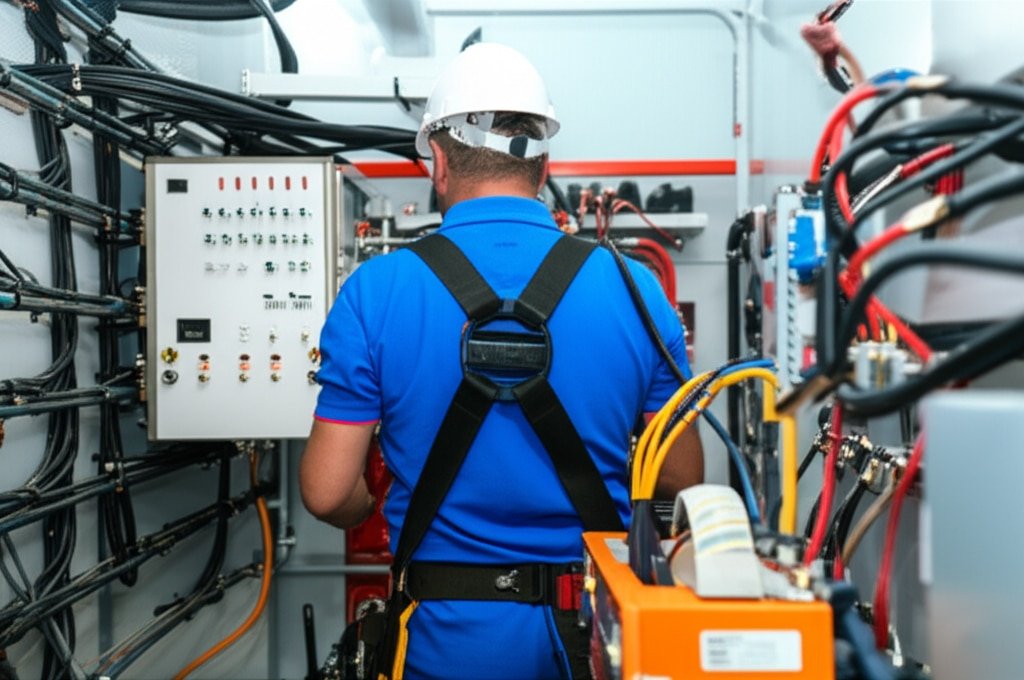
Electrical maintenance accidents kill 160 workers annually in the US alone. Proper LOTO procedures with cable gland systems can prevent these tragedies.
Effective lockout/tagout procedures1 for cable gland systems require isolation of all energy sources, proper identification of cable entry points, verification of zero energy state2, and systematic documentation of each step to ensure worker safety during maintenance operations.
Last week, Hassan called me in panic. His maintenance team had a near-miss incident while servicing a junction box in their refinery. The cable glands weren’t properly isolated, and energized cables remained connected. This conversation reminded me why proper LOTO procedures are literally life-and-death matters.
Table of Contents
- What Are the Essential LOTO Steps for Cable Gland Systems?
- How Do You Identify and Isolate All Energy Sources in Cable Gland Installations?
- What Special Considerations Apply to Different Cable Gland Types During LOTO?
- How Do You Verify Complete Energy Isolation Before Starting Work?
What Are the Essential LOTO Steps for Cable Gland Systems?
Cable gland systems present unique challenges that standard LOTO procedures don’t always address. Understanding these specifics can save lives.
The six essential LOTO steps for cable gland systems include: preparation and planning, shutdown of equipment, isolation of energy sources, application of lockout devices, verification of isolation, and maintenance of isolation throughout the work period.

Step 1: Preparation and Planning
Before touching any cable gland system, you need comprehensive documentation:
- Cable routing diagrams: Know exactly which cables pass through each gland
- Energy source identification: Map all electrical, pneumatic, and hydraulic connections
- Equipment specifications: Understand voltage levels, current ratings, and control circuits
- Emergency procedures: Have clear escalation paths for unexpected situations
I always tell my clients: “Assume every cable is live until proven otherwise.” This mindset has prevented countless accidents.
Step 2: Equipment Shutdown
Proper shutdown sequence for cable gland systems:
| Step | Action | Verification Required |
|---|---|---|
| 1 | Normal equipment shutdown | Confirm process completion |
| 2 | Isolate primary power sources | Visual confirmation at disconnect |
| 3 | Isolate control circuits | Test control functions |
| 4 | Isolate auxiliary systems | Check all secondary power |
Step 3: Energy Source Isolation
This is where cable glands require special attention. Unlike simple electrical panels, cable gland installations often involve:
- Multiple entry points: Each gland may carry different energy types
- Buried or concealed routing: Cables may not be immediately visible
- Interconnected systems: One cable gland box may serve multiple equipment pieces
David recently shared with me: “Chuck, we discovered our junction box had 12 different energy sources coming through 8 cable glands. Your systematic approach helped us identify them all safely.”
Step 4: Lockout Device Application
For cable gland systems, lockout devices must address:
- Electrical disconnects: Lock all upstream breakers and switches
- Cable gland access: Secure enclosure doors and covers
- Individual cable isolation: Use cable lockout devices where applicable
- Control circuit isolation: Lock out all control power sources
How Do You Identify and Isolate All Energy Sources in Cable Gland Installations?
Energy source identification in cable gland systems is more complex than standard electrical work. Multiple energy types often converge at single points.
Effective energy source identification requires systematic cable tracing, documentation review, physical inspection of all cable glands, testing for residual energy, and verification with multiple detection methods before declaring systems safe.
Cable Tracing Methodology
Visual Inspection Process:
- Start from the equipment being serviced
- Follow all cables to their source
- Document each cable gland entry point
- Identify cable types and purposes
- Verify against electrical drawings
Documentation Cross-Reference:
- Single-line diagrams
- Cable schedules
- As-built drawings
- Previous work orders
- Manufacturer specifications
Energy Type Classification
Different cable types through glands carry different hazards:
Power Cables:
- High voltage (>1000V): Requires specialized PPE and procedures
- Low voltage (≤1000V): Standard electrical safety procedures
- Control power: Often overlooked but equally dangerous
Signal Cables:
- Instrumentation: May carry loop power
- Communication: Usually low energy but verify
- Fiber optic: No electrical hazard but may indicate active systems
Auxiliary Systems:
- Pneumatic control lines
- Hydraulic connections
- Steam tracing circuits
Hassan told me: “We found a 24V control circuit that everyone assumed was safe. It was actually connected to a critical safety system that could have caused a major incident.”
Detection Equipment Requirements
For thorough energy verification, use multiple detection methods:
- Non-contact voltage detectors: Initial screening
- Digital multimeters: Precise voltage measurement
- Clamp meters: Current verification
- Thermal imaging: Hot spot identification
- Oscilloscopes: Complex waveform analysis when needed
What Special Considerations Apply to Different Cable Gland Types During LOTO?
Different cable gland materials and designs create unique LOTO challenges. Understanding these differences prevents oversights that could prove fatal.
Special LOTO considerations include: explosion-proof glands requiring flame-path integrity maintenance, EMC glands needing continuity preservation, marine glands with corrosion-related access issues, and armored cable glands with mechanical hazards from cable armor.
Explosion-Proof Cable Glands
Critical Requirements:
- Never break flame-path integrity3 during maintenance
- Maintain proper thread engagement
- Use only certified replacement parts
- Document any modifications
LOTO Specific Steps:
- Verify area classification before work begins
- Use intrinsically safe tools4 only
- Maintain continuous bonding during disassembly
- Test flame-path integrity before re-energization
EMC Cable Glands
Electromagnetic Compatibility Considerations:
- Maintain shielding continuity during work
- Use proper grounding techniques
- Avoid creating ground loops5
- Test EMC performance after reassembly
Common Mistakes to Avoid:
- Removing all cable glands simultaneously
- Using non-conductive tools inappropriately
- Failing to maintain equipment grounding
- Ignoring cable shield terminations
Marine and Harsh Environment Glands
Environmental Challenges:
- Corrosion may make removal difficult
- Sealing compounds may be hardened
- Salt deposits can conduct electricity
- Moisture ingress creates additional hazards
Special Procedures:
- Use penetrating oils before disassembly
- Clean all surfaces thoroughly
- Test insulation resistance before and after work
- Apply protective coatings as specified
At Bepto, we provide detailed LOTO procedures specific to each cable gland type we manufacture. This documentation has helped our clients avoid numerous potential accidents. 😉
Armored Cable Considerations
Mechanical Hazards:
- Sharp armor edges can cause cuts
- Stored energy in bent armor
- Potential for armor to conduct electricity
- Heavy cables creating lifting hazards
Safety Measures:
- Use proper PPE including cut-resistant gloves
- Support cable weight during work
- Verify armor grounding before handling
- Use proper lifting techniques for heavy cables
How Do You Verify Complete Energy Isolation Before Starting Work?
Verification is the most critical step in LOTO procedures. Assumptions kill – only proper testing confirms safety.
Complete energy isolation verification requires testing at multiple points, using multiple methods, documenting all measurements, having qualified personnel perform verification, and maintaining continuous monitoring throughout the work period.
Multi-Point Testing Strategy
Primary Testing Points:
- At the energy source (breaker, valve, etc.)
- At intermediate connection points
- At the cable gland entry
- At the equipment being serviced
Testing Sequence:
- Test your meter on known live circuit
- Test at each verification point
- Test your meter again on known live circuit
- Document all readings
Documentation Requirements
Essential Records:
- Date and time of each test
- Personnel performing verification
- Meter serial numbers and calibration dates
- Voltage readings at each point
- Any anomalies discovered
David shared this experience: “Our documentation saved us during an OSHA inspection. They were impressed with our systematic approach to cable gland LOTO procedures.”
Continuous Monitoring
During Extended Work:
- Periodic re-verification (every 2-4 hours)
- Shift change verification
- After any system disturbance
- Before re-energization
Warning Signs to Watch For:
- Unexpected voltage readings
- Equipment starting unexpectedly
- Unusual sounds or smells
- Changes in environmental conditions
Re-energization Procedures
Before Removing LOTO:
- Complete all work and testing
- Remove all tools and personnel
- Remove lockout devices in reverse order
- Verify proper cable gland reassembly
- Test systems before full operation
Final Verification Steps:
- Insulation resistance testing
- Continuity verification
- Proper torque on all connections
- Sealing integrity confirmation
Hassan recently told me: “Following your systematic re-energization procedure prevented a major equipment failure. We discovered a loose connection during final testing.”
Conclusion
Proper LOTO procedures for cable gland systems require systematic planning, thorough execution, and continuous verification to prevent fatal accidents.
FAQs About Cable Gland LOTO Procedures
Q: How often should LOTO procedures be reviewed and updated for cable gland systems?
A: Review LOTO procedures annually or after any incident, equipment modification, or regulatory change. Cable gland systems evolve with plant modifications, so documentation must stay current to maintain safety effectiveness.
Q: What’s the most common mistake in cable gland LOTO procedures?
A: The biggest mistake is assuming all cables in a gland carry the same energy type or source. Each cable must be individually identified and verified. I’ve seen cases where control cables and power cables shared the same gland with different energy sources.
Q: Can I work on cable glands while equipment is energized if I use proper PPE?
A: Never work on cable glands with energized systems unless it’s an emergency with proper hot work procedures. Even with PPE, the risk is too high. Always follow proper LOTO procedures to achieve zero energy state.
Q: How do I handle cable glands in areas where complete shutdown isn’t possible?
A: For critical systems requiring continuous operation, use alternative isolation methods like temporary barriers, individual cable isolation, or hot work procedures with qualified electrical workers. Consult with safety professionals for these complex situations.
Q: What training is required for personnel working on cable gland LOTO procedures?
A: Personnel need OSHA-compliant LOTO training plus specific instruction on cable gland systems, energy source identification, and verification procedures. At Bepto, we provide technical training to help your teams understand our products’ specific LOTO requirements.
-
Review the official OSHA standard for The Control of Hazardous Energy (Lockout/Tagout). ↩
-
Understand the definition and importance of achieving a zero energy state before performing maintenance. ↩
-
Learn about the critical concept of flame-path integrity in explosion-proof enclosures. ↩
-
Discover the principles of intrinsic safety and the requirements for tools used in hazardous locations. ↩
-
Explore the causes of electrical ground loops and techniques to eliminate them in sensitive systems. ↩



